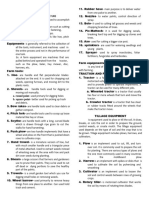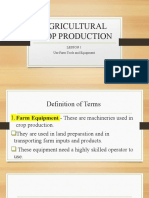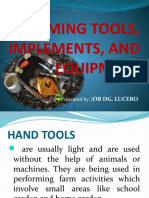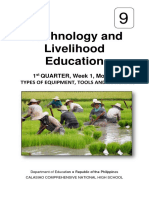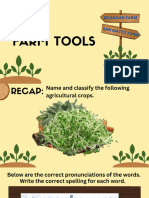0 ratings0% found this document useful (0 votes)
1 viewsTLE_7_REVIEWER
TLE_7_REVIEWER
Uploaded by
aleanaesguerra162Copyright:
© All Rights Reserved
Available Formats
Download as DOCX, PDF, TXT or read online from Scribd
TLE_7_REVIEWER
TLE_7_REVIEWER
Uploaded by
aleanaesguerra1620 ratings0% found this document useful (0 votes)
1 views5 pagesCopyright
© © All Rights Reserved
Available Formats
DOCX, PDF, TXT or read online from Scribd
Share this document
Did you find this document useful?
Is this content inappropriate?
Copyright:
© All Rights Reserved
Available Formats
Download as DOCX, PDF, TXT or read online from Scribd
Download as docx, pdf, or txt
0 ratings0% found this document useful (0 votes)
1 views5 pagesTLE_7_REVIEWER
TLE_7_REVIEWER
Uploaded by
aleanaesguerra162Copyright:
© All Rights Reserved
Available Formats
Download as DOCX, PDF, TXT or read online from Scribd
Download as docx, pdf, or txt
You are on page 1of 5
TLE 7 REVIEWER Selling to Other Countries- you can fins
2nd Quarter products in demand in other countries and
sell them there.
TYPE OF TEST FARM TOOLS AND EQUIPMENT
TEST I- True or False (1-11)
TEST II- Matching Type (12-22) TOOLS FOR LAND CLEARING
TEST III- Multiple Choice (23-33) Axe- is used for chopping down tree trunks,
TEST IV- Modified True or False (34-44) branches, and large roots.
TEST V- Identification (45-56) Cutlass or Machete- used for slashing
TEST VI- Essay (57-60) shrubs, weeding and carving points at the
bottom end of pegs and poles.
INTRODUCTION IN AGRICULTURE Mattock- is used for digging and uprooting
The word “agriculture” comes from the small stumps.
Latin words AGER and CULTURA. Crowbar- can also be used for digging holes
Ager means land or field, and cultura means in seed planting.
cultivation. Hand Saw- it is used for cutting wood.
AGRICULTURE implies cultivating land,
which involves growing crops and raising TOOLS FOR LAND PREPARATION
livestock for economic reasons. Garden Fork- used for loosening, lifting,
and turning soil over in gardening and
farming.
CAREER OPPORTUNITIES IN Shovel- is a tool for digging, lifting and
AGRICULTURE moving bulk materials such as soil, coal,
gravel, snow, sand an ore.
Growing Crops- you can grow and sell Spade- it is used to lift soil particles, pen
fruits vegetables or other plants. manure, and other objects into wheel
Raising Animals- you can raise chickens, barrows.
cows or pigs and sell their products like Rake- used to collect leaves, hay, grass, etc.
eggs, milks and meats. and in gardening for loosening, the soil, and
Selling Farm Supplies- you can provide light weeding.
seeds, fertilizers, or tools to other farmers. Watering can- a portable container, usually
Making Food- you can process fruits, with a handle and a spout, used to water
vegetables, or grains to make things like plants by hand.
jams, sauces or snacks.
Farm Visits (Agri Tourism)- you can invite NURSERY MANAGEMENT AND
people to visit your farm and show them PLANTING TOOLS
how things are grown. Trowel- is used for breaking soil, digging
Offering Services- you can help farmers small holes, planting and weeding and
manage their farms. Install irrigation system transferring plants to pots.
or control pests. Hand fork- is used to crush soil clods on
Organic Farming- you can grow crops or sed beds, break surface crust, and loosen soil
raise animals using natural methods and sell particles.
organic products. Soil Sieves- are shallow metal pans that are
Making Special Products- you can create made of metal mesh material that allow soil
unique things using agricultural ingredients particles to pass through.
like special recipes. Seed boxes- are small, shallow wooden
Using Technology- you can create or sell boxes usually filled with potting soil that
tools and equipment that help farmers to tiny seeds need for germination.
work more efficiently.
TOOLS FOR PLANT PROTECTION Moisture Retention- good soil can hold
Hand Sprayer- used to apply small droplets some water, but not too much.
of liquid pesticide onto the leaf surface of Texture- the soil should have a nice balance
plants. of different sized particles like sand, silt, and
Knapsack sprayer- are used on larger plots clay.
with numerous plants. pH Level- the soil should have the right
Respirator- is a light plastic covering that is amount of acidity or alkalinity for the plants.
worn over the nostrils and the mouth. Organic Matter- good soil has things like
old plants or compost.
No Contaminants- the soil should not have
bad things like chemicals or heavy metals.
Soil Structure- good soil has a nice texture
TOOLS USED FOR PRUNING that helps plant grow.
Garden Shears- used to cut down unwanted 4. Consider the weather in the places. Make
shoots from shrubs, especially those that are sure it matches what your crops or animals
used as hedges. needed.
Frame Saw- is used to remove woody 5. Check if there are rivers, lakes, or wells
branches from orchard crops or ornamental nearby. You need enough water for irrigation
plants. or for your animals to drinks.
Pruning Knife- used for thinning delicate 6. See how close potential sites are to places
branches, removing suckers and shaping where you can sell your products.
bushes. 7. Find nearby electricity, roads, and storage
facilities.
EQUIPMENTS USED FOR LAND 8. Consider how your farm will impact the
PREPARATION environment.
Tractor with a plow- the plough has metal
blades that can be slice the soil and turn it METHODS IN PREPARING LAND
over. FOR PLANTING
Bulldozer- used for moving large amounts PLOWING- means turning over the top
of earth and soil. layer of soil using a special tool called a
Disc plows- they are made to work on heavy plow.
clayey soils and roughs stony soils. HARROWING- it makes the soil smoother
Harrows- are equipment used for breaking and ready for planting seeds.
up large soil clouds into smaller ones. TILLING- is a general term for preparing
Ridgers- used to prepare the harrowed field the soil. Farmers use of tools or machines
into ridges and furrows. like cultivators to loosen the soil.
MAKING RAISED BEDS- this means
making long, narrow areas of higher soil. It
AGRICULTURAL PRACTICES helps the drainage and make it easier for
1. Decide what type of farming you want to plants to grow.
do and how much you want to produce. MULCHING- involves spreading a
Consider who will buy your products and material layer on the soil around the plants.
how big your farm should be. PROTECTING THE SOIL- conservation
2. Find out about different areas suitable for tillage is a way of preparing the soil that
farming. Look at the weather, soil quality, does not disturb it too much.
water availability you need as follows. LEVELING SLOPES- farmers create flat
3. You want the soil to be good for growing areas called terraces on hilly or sloping land.
your crops or keeping your animals healthy. COMPOSTING- before planting, farmers
Fertility- good soil is full of nutrients that may add things like compost or manure to
plants need to grow. make the soil richer in nutrients.
Drainage- the soil should let extra water
flow away easily so plants don’t get too wet.
Planting and Transplanting Pulling or Uprooting- some crops such as
1. DIRECT SEEDING- It is crucial to carrots, radishes, or potatoes are taken out of
prepare the beds before direct seeding. The the ground by pulling the whole plant.
beds should be free from weeds and stones Shaking or Beating- certain fruits like
and well-leveled. apples or pears can be collected by gently
2. BROADCASTING- or “sabog tanim” or shaking or tapping the tree branches.
scatter planning is a method of planting by Threshing- when it comes to grain crops
which seeds are scattered over well-prepared like wheat or rice, we need to separate the
soil. edible grains from the stalks or husks.
3. DRILLING- seeds are planted in neat Using Machines- on big farms, machines
rows using a special seed drill machine. are sometimes used to help with harvesting.
Drilling is often used for crops like corn,
soybeans, and vegetables. POST HARVESTING
4. HILL DROPPING- seeds are placed in Cleaning- the harvested crops are cleaned to
small mounds or hills for crop like squash, remove dirt or unwanted things.
melons, and cucumbers. Sorting and Grading- the crops are sorted
5. Transplanting- this method moves young into groups based on size, color, ripeness
plant called seedling from a nursery to the and quality.
field. Transplanting is commonly done for Packaging- the crops are carefully placed in
vegetables and flowers. containers or packaging materials that
6. Direct Seeding- seeds are planted directly protect them during transportation.
into the ground without being started Storage- the harvested crops must be stored
indoors in a nursery. in a place with the right temperature,
7. Bed Planting- the soil is made into raised humidity, and ventilation.
beds, and seeds or seedlings are planted in
rows on top of these beds.
8. Container Planting- seeds or seedlings Agricultural Hazards and Risks in Farm
are in individual containers filled with Operation
special soil or growing material. Weather-Related Risks- farm can be
9. Hydroponics- they are placed in a water affected by droughts, floods, storms, and
solution with all the nutrients they need to extreme temperatures.
grow. Pests and Diseases- Farms face risks of
10. Aeroponics- plants are grown without pests and diseases that can harm plants,
soil or water. The roots hang in the air, and animals and agricultural products.
nutrient mist is sprayed on them. Market Risks- Farmers are at risk related to
changing prices, demands, and trade
policies.
Harvesting and Post Harvesting Financial Risks- Running a fam requires
money for investments, expenses and
HARVESTING unexpected situations.
Is the process of collecting plants, animals, Occupational Hazard- farm work involves
or fish (as well as fungi) as food, especially physical labor and exposure to dangers such
the process of gathering mature crops. as accidents with machinery, falls etc.
Environmental Risks- farming practices
SIMPLE TECHNIQUES IN can affect the environment, causing risks
HARVESTING like soil erosion, water pollution from
Hand Harvesting- this means using our chemicals.
hands to carefully pick up fruits, vegetables, Technological Risks- using new farm
or flowers from the plants. technologies, like machinery, genetically
Cutting or Snapping- for certain crops like modified crops, or automation can introduce
lettuce, spinach or herbs, we cut off the risks.
leaves when they have grown enough.
ANIMAL PRODUCTION CORNISH CROSS (BROILERS)
They grow quickly and have a lot of breast
Livestock production is an essential meat, making them ideal for meat
component of world agriculture, production.
contributing to food security, ISA BROWN
nutrition, poverty alleviation, They are known for their high egg
and economic growth. production, especially brown eggs, and are
often kept in backyards.
POULTRY KABIR
Including birds like chickens and ducks Are crossbreed chickens mainly raised for
raised for their meat and eggs, is essential meat. They grow fast convert food
for several reasons. Poultry provides us with efficiently.
food.
TYPES OF POULTRY TOOLS AND EQUIPMENT IN
Chickens- Are the most common type of POULTRY AND LIVESTOCK
poultry. They are raised for their meat and PRODUCTION
eggs. FEEDERS
Ducks- People raised them for their meat, These containers hold and provide food for
eggs, or as pets. Duck has a tasty flavor, and broiler chickens. They make it easy for
duck eggs are bigger than chicken eggs. The chickens to eat and ensure they have
Turkeys- are bigger than chickens and have enough.
features like a fleshy part on their heads WATERERS
called “wattle”. Waterers are containers that hold water for
Geese- Are larger birds raised for their meat, the chickens to drink. They help keep the
eggs, and feathers. Geese are also good at chickens hydrated and healthy.
protecting and guarding. HEAT LAMPS
Quails- Are smaller birds raised for their Heat lamps provide warmth to baby chicks.
eggs and meat. Quail eggs are smaller than They make sure chicks stay warm and
chicken eggs. comfortable, just like being with mother.
Pigeons- Also known as rock doves, can be VENTILATION SYSTEM
raised for their meat or kept as pets. Some These system help keep the air fresh and at
people even use for them for racing. good temperature inside the chicken house.
CAGES OR HOUSING
DIFFERENT KINDS OF CHICKENS Cages or housing structures provide a safe
PHILIPPINE NATIVE CHICKEN
Is a local breed well-suited to the Philippine
climate and can resist common poultry place for broiler chickens to live and grow.
disease. LIGHTING SYSTEM
WHITE LEGHORN Special lights are used to control the amount
They are good at laying many big white of light the chickens get.
eggs and efficiently converting their food SCALES
into eggs. Scales are used to weigh the chickens at
RHODE ISLAND RED different stages. These scales help farmers
Are versatile meat and egg production birds. know if the chickens are growing healthy.
They have brown feathers, are known for WASTE MANAGEMENT TOOLS
laying eggs. Tools are used to manage the waste from the
PLYMOUTH ROCK (BARRED ROCK) chickens. They help clean up the waste and
Are dual-purpose chickens, meaning they keep the farm clean and healthy.
are suitable for meat and eggs. EGG COLLECTION TRAYS
SUSSEX
They are known for their good meat and for
laying brown eggs.
These trays are used to collect the eggs that
the hens lay. They help keep the eggs safe
and prevent them from getting broken.
EGG INCUBATOR
An egg incubator is a special machine that
helps eggs hatch into baby chicks. It
provides the right temperature and humidity
for the eggs to grow.
BROODERS
Brooders are like warm homes for baby
chicks. They keep them comfortable and
provide the right amount of heat need when
they are young.
NESTING BOXES
Nesting boxes are comfortable spaces where
hens lay their eggs.
You might also like
- Agricultural Crop Production Grade 9Document22 pagesAgricultural Crop Production Grade 9Markus Amevill100% (10)
- A Snapshot of Demand For Adult-Use Cannabis in IllinoisDocument27 pagesA Snapshot of Demand For Adult-Use Cannabis in IllinoisTodd FeurerNo ratings yet
- Module 2 Lesson 2Document75 pagesModule 2 Lesson 2KHARINE HAWIHAONo ratings yet
- Plant PropagationDocument18 pagesPlant PropagationAllen Jade PateñaNo ratings yet
- Plant CropsDocument119 pagesPlant CropsManilyn GaranganaoNo ratings yet
- Agriculture Notes 5 Term1 NotesDocument22 pagesAgriculture Notes 5 Term1 NoteseverestmanyatiNo ratings yet
- Q1 Part 6Document22 pagesQ1 Part 6Tsukigami TempestNo ratings yet
- Lesson 1 Agricultural Crop Production: Use of Farm ToolsDocument25 pagesLesson 1 Agricultural Crop Production: Use of Farm Toolsdee dreamer13No ratings yet
- Module 1Document12 pagesModule 1ashi ravenNo ratings yet
- Module 1Document83 pagesModule 1Panfilo MaglasangNo ratings yet
- Basics in Agriculture SummaryDocument6 pagesBasics in Agriculture SummaryMerry Carlien RudasNo ratings yet
- WRITTEN REPORT IN AGRI Lesson 1Document7 pagesWRITTEN REPORT IN AGRI Lesson 1Mylene SalamatNo ratings yet
- AFA Module 2 TwoDocument9 pagesAFA Module 2 TwoRichelyn Joy MicarosNo ratings yet
- Lesson 1 Agricultural Crop Production: Use of Farm ToolsDocument25 pagesLesson 1 Agricultural Crop Production: Use of Farm Toolsdee dreamer13No ratings yet
- Agricultural Crops Production NC I1 NewDocument18 pagesAgricultural Crops Production NC I1 Newsumaira abas100% (1)
- Agricultural Crops Productin NciiDocument14 pagesAgricultural Crops Productin NciiMikay Panaligan JoseNo ratings yet
- Tle Reviewer PDFDocument4 pagesTle Reviewer PDFarseanchadrick63No ratings yet
- Lesson 2Document53 pagesLesson 2Quenie CantorNo ratings yet
- Agricultural Crops Production NC IIDocument21 pagesAgricultural Crops Production NC IIsumaira abasNo ratings yet
- Lesson 1 Tle Seven Use of Farm Tools.Document53 pagesLesson 1 Tle Seven Use of Farm Tools.Jhonxen Pogi100% (1)
- Tillage and Land PreparationDocument52 pagesTillage and Land PreparationdonitamaediosanoNo ratings yet
- Scrap Book in TLE: Simple Farm Tools Refer To Simple Tools Used To Do WorkDocument16 pagesScrap Book in TLE: Simple Farm Tools Refer To Simple Tools Used To Do WorkAbegail Joy LumagbasNo ratings yet
- .Pending 1705722642 321807857 Scrap Book in TLEDocument15 pages.Pending 1705722642 321807857 Scrap Book in TLEJessie PasomalaNo ratings yet
- Tle 09Document15 pagesTle 09Lance GabrielNo ratings yet
- Handouts No. 3Document8 pagesHandouts No. 3Angelyn RodulloNo ratings yet
- Common Farm Equipment Tle AgricultureDocument11 pagesCommon Farm Equipment Tle AgricultureJyrah DuronNo ratings yet
- Standard 5 English Notes Term 1 2025 EdtDocument48 pagesStandard 5 English Notes Term 1 2025 EdtkambereallyNo ratings yet
- Farming Tools and EquipmentDocument54 pagesFarming Tools and EquipmentJohn JohnNo ratings yet
- Agri 12 - QTR 2 - LAS - Week 3Document11 pagesAgri 12 - QTR 2 - LAS - Week 3Raquel B. GarridoNo ratings yet
- GRADE 8 (Week 2)Document39 pagesGRADE 8 (Week 2)Redginald CalderonNo ratings yet
- UntitledDocument99 pagesUntitledDanny R. SalvadorNo ratings yet
- Lesson 1 Hand ToolsDocument31 pagesLesson 1 Hand Toolsjoylyn pasaliNo ratings yet
- Farm Tools and EquipmentsDocument5 pagesFarm Tools and EquipmentsAira Acob MagnoNo ratings yet
- Use Farm Tools and EquipmentDocument34 pagesUse Farm Tools and Equipmentjherson boholNo ratings yet
- Farm Tools Equipment Inputs and LaborDocument6 pagesFarm Tools Equipment Inputs and Laborondogsherwin22No ratings yet
- Farm ToolsDocument23 pagesFarm ToolsShirley PicioNo ratings yet
- Grade 4 - Q2 TVE LessonDocument14 pagesGrade 4 - Q2 TVE LessonHF ManigbasNo ratings yet
- 1 Hele/Tle Chapter 5 - Planning A Vegetables GardenDocument18 pages1 Hele/Tle Chapter 5 - Planning A Vegetables GardenJoven Torejas100% (1)
- Herb Garden and Vegetable Garden and ToolsDocument17 pagesHerb Garden and Vegetable Garden and ToolsIrene LebrillaNo ratings yet
- Farm ToolsDocument34 pagesFarm ToolsOlive BautistaNo ratings yet
- Paliparan National High SchoolDocument22 pagesPaliparan National High SchoolLeeanah Delovino CruzNo ratings yet
- AGRI 7 LESSON 1 Farm Tools and EquipmentDocument48 pagesAGRI 7 LESSON 1 Farm Tools and EquipmentArianne Joy EsquivelNo ratings yet
- Agronomy (TLE 10) : Agricultural Crop ProductionDocument6 pagesAgronomy (TLE 10) : Agricultural Crop ProductionHelian Zoe Eloise YvetteNo ratings yet
- Tool Implement EquipmentDocument48 pagesTool Implement EquipmentJob LuceroNo ratings yet
- 3RD Grading PERFORMING NURSERY OPERATIONS Grade 11Document8 pages3RD Grading PERFORMING NURSERY OPERATIONS Grade 11Jennifer Duran100% (1)
- Standard 5 Notes Term 1 2025Document46 pagesStandard 5 Notes Term 1 2025kambereallyNo ratings yet
- First Quarter Tle 9 Week IDocument8 pagesFirst Quarter Tle 9 Week IMichelle Navarro100% (1)
- Farm Tools in ADocument1 pageFarm Tools in AclarincelouigenotivaNo ratings yet
- Information-Sheet ToolsDocument6 pagesInformation-Sheet ToolsLovely Adellia Ventura JacildoneNo ratings yet
- Afa Hand ToolsDocument2 pagesAfa Hand ToolsRaquel Dela CruzNo ratings yet
- QA - TLE - AGRI CROP 7 - Q3 - WEEK 1 6 Booklet Type PDFDocument36 pagesQA - TLE - AGRI CROP 7 - Q3 - WEEK 1 6 Booklet Type PDFMa Tyrese GutierrezNo ratings yet
- Crop-production Ppt (1)Document41 pagesCrop-production Ppt (1)chamy.shi0n.83No ratings yet
- Lesson3 FarmToolsDocument38 pagesLesson3 FarmToolsJoshua ZernaNo ratings yet
- STLE 107 MODULE Week 6Document31 pagesSTLE 107 MODULE Week 6renz daveNo ratings yet
- Tle 7Document8 pagesTle 7Sharah Mae Acorin-CuenoNo ratings yet
- St. Andrew Montessori and High School Inc., Nancayasan, Urdaneta City, Pangasinan S.Y. 2020-2021 Tle/ Epp 5Document2 pagesSt. Andrew Montessori and High School Inc., Nancayasan, Urdaneta City, Pangasinan S.Y. 2020-2021 Tle/ Epp 5rheyNo ratings yet
- TLE 8 Farm Equipments HandoutDocument4 pagesTLE 8 Farm Equipments Handouttakeomijis29No ratings yet
- Calibration & Techniques of Operations On Working Tools & EquipmentsDocument47 pagesCalibration & Techniques of Operations On Working Tools & EquipmentsDebebe DeguNo ratings yet
- Module 3Document23 pagesModule 3diegocmakoNo ratings yet
- The Essential Guide to Self-Sufficient Living: Vegetable Gardening, Canning and Fermenting, Keeping Chickens, and MoreFrom EverandThe Essential Guide to Self-Sufficient Living: Vegetable Gardening, Canning and Fermenting, Keeping Chickens, and MoreNo ratings yet
- Ultimate Indoor Garden PDFDocument3 pagesUltimate Indoor Garden PDFAnonymous iFOsKJ0% (1)
- Rural Development Unit I Notes PDFDocument9 pagesRural Development Unit I Notes PDFjameelshaikh97155No ratings yet
- Design and Implementation of Multi Seed Sowing Machine: Research PaperDocument8 pagesDesign and Implementation of Multi Seed Sowing Machine: Research Paper113314No ratings yet
- The Organic Revolution - Nourishing Body and SoulDocument6 pagesThe Organic Revolution - Nourishing Body and SoulMarie Landry's Spy ShopNo ratings yet
- Piggery BookletDocument30 pagesPiggery BookletVeli Ngwenya100% (4)
- Government Intervention On Rice Price Ceiling Analysis in Indonesia - Tjoa Josua Evan - 29120635 - Emba64Document7 pagesGovernment Intervention On Rice Price Ceiling Analysis in Indonesia - Tjoa Josua Evan - 29120635 - Emba64Propena ButanaNo ratings yet
- 2021 NullDocument7 pages2021 NullamerofficialyNo ratings yet
- Cultivation of Foxtail MilletDocument13 pagesCultivation of Foxtail MilletPiyush RajNo ratings yet
- SPES GARDENING ACCOMPLISHMENT FORM 1 1Document1 pageSPES GARDENING ACCOMPLISHMENT FORM 1 1truthNo ratings yet
- 2.04-Suardi N-Edi R-Dede R-Yakub S PDFDocument15 pages2.04-Suardi N-Edi R-Dede R-Yakub S PDFkamalNo ratings yet
- Kenny Groundnut Production in Zimbabwe Manual FinalDocument39 pagesKenny Groundnut Production in Zimbabwe Manual FinalKennedy MabehlaNo ratings yet
- Precision Farming Pride For Farmers-150mt BrinjalDocument2 pagesPrecision Farming Pride For Farmers-150mt BrinjalKranthi RajNo ratings yet
- ECO Grouping PDFDocument12 pagesECO Grouping PDFmxmpwwrhz4No ratings yet
- Agricultural Soil Carbon Credits Protocol SynthesisDocument42 pagesAgricultural Soil Carbon Credits Protocol SynthesisFooyNo ratings yet
- Pesticide Regulatory Policies SPRTDocument23 pagesPesticide Regulatory Policies SPRTprecaute100% (1)
- Watercourse Improvement English PDFDocument12 pagesWatercourse Improvement English PDFKhurram SherazNo ratings yet
- Tribal Development in Tamil NaduDocument6 pagesTribal Development in Tamil NaduPraharsh MNo ratings yet
- Journal of Hill Agriculture 2011 Vol 2Document37 pagesJournal of Hill Agriculture 2011 Vol 2editorinchiefjhaNo ratings yet
- Supply Chains For Medicinal PlantsDocument16 pagesSupply Chains For Medicinal PlantsBraj DasNo ratings yet
- Formulasi Nuclear Polyhedrosis Virus (NPV) Untuk Mengendalikan Ulat Grayak Padi (Mythimna Separata Walker) Pada Tanaman PadiDocument9 pagesFormulasi Nuclear Polyhedrosis Virus (NPV) Untuk Mengendalikan Ulat Grayak Padi (Mythimna Separata Walker) Pada Tanaman PadinurulNo ratings yet
- Ig1 Evm Ch-3 Notes 2Document20 pagesIg1 Evm Ch-3 Notes 2Ajit GoleyNo ratings yet
- Grant Proposal For Maize Grain-Beans ProductionDocument12 pagesGrant Proposal For Maize Grain-Beans ProductionMohamed Abdi100% (1)
- Arbuckle-Hammer2019 Article TheRiseOfPastoralismInTheAncieDocument59 pagesArbuckle-Hammer2019 Article TheRiseOfPastoralismInTheAncieDan ABNo ratings yet
- Exam HorticultureDocument46 pagesExam Horticulturemischel vegafriaNo ratings yet
- CV For Tendai Justin Mutenje Dover DEDocument25 pagesCV For Tendai Justin Mutenje Dover DEKons ElungiNo ratings yet
- An Annotated Permaculture BibliographyDocument9 pagesAn Annotated Permaculture BibliographySeed Savers NetworkNo ratings yet
- Biomass Technology in GhanaDocument10 pagesBiomass Technology in GhanaGreenattics AtticsNo ratings yet
- Final GPP Smepa 2021 - 2022Document28 pagesFinal GPP Smepa 2021 - 2022Mark Gil Jalbuena AltezaNo ratings yet
- Gardener (Scout Interest Badge) PrintDocument1 pageGardener (Scout Interest Badge) Printt karthikNo ratings yet
























